Seeking Divinity - Talks by Dr John S. Hislop
This is a compilation of his articles and speeches by associates in the Sathya Sai Society of America, Tustin, California, published in 1997, one year after his death.
John Hislop was the major promoter of Sathya Sai Baba in the USA and elsewhere, whose first book (Conversations with Bhagavan Sri Sathya Sai Baba) attracted many to the guru due to its sensational claims and simple presentation. The follow-up book (My Baba and I) was also a widely sold hagiography, also advancing ‘incredible’ claims of miracles, which have always been the key attraction of Sai Baba.
Seeking Divinity is representative of many of the countless books which try to promote on Sathya Sai Baba, his doctrines and activities through a mixture of anecdotal and proselytizing materials set in the context of the author’s own experience of the guru. Hislop relates incidents together with Sai Baba and repeats various parable-type stories he heard from him. There are question and answer sessions from some of his proselytizing meetings around the world –those published here are chiefly from the USA, New Zealand and Japan.
After many gurus and failed spiritual questing, Hislop came in 1968 to Sathya Sai Baba and soon embraced him as the true source of wisdom (see Conversations…). Hislop soon threw all caution to the winds and proclaimed himself a follower. In his original conversations he questioned Sai Baba on points needing clarification, while showing he accepted all he was told, however unlikely, and was without any doubts about Sai Baba’s many claims. His sycophancy is seen just as strongly throughout Seeking Divinity.
Like all Sai Baba publications, no divergence from the accepted teachings is tolerated; no investigatory dialogue is allowed if it raises issues not raised by – or otherwise acceptable to – Sathya Sai Baba himself. Further, Hislop systematically avoids any contextual discussion of the many contradictions in Sai Baba’s statements (and actions). Nor has he the contrary and even mutually exclusive doctrines and ideas Sai Baba has promoted (in his obvious agenda to provide a pick-and-mix menu to attract the maximum number of people) and has made flagrantly false and absurd statement and claims in many discourses and interviews. (See here)
Here I shall comment on just a few of the many highly doubtful and often simplistic views Hislop puts forward, none of which add any real content to what Sathya Sai Baba has himself said.
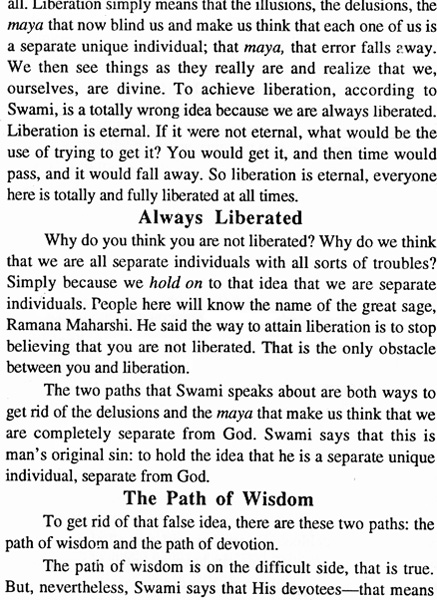 |
Comment: That Hislop repeats the old Hindu saw ‘Illusion is the ignorance of individuality (ego)’ and compounds the ultimately vague absurdity by repeating SB’s mistaken idea that we are always liberated hardly deserves even a comment. Yet there are those who believe this kind of blather. That” the way to attain liberation” is mentioned is a total contradiction… but that it is simply “to stop believing you are not liberated” is such facile smart talk without any substance whatever. In other contexts Sai Baba has explained the vast difficulty of becoming liberated, how one must undergo countless births and endless sufferings before getting final ‘liberation’ only shows how trite his entire speculative system is. The path of wisdom is clearly not one that Hislop took, since he was devoted entirely to Sai Baba and never questioned him or himself either (after he became a blind believer, that is). It is also noteworthy that Sai Baba has said all those who saw him produce a lingam from his mouth would be liberated… but told Hislop later on that he would have to undergo another birth before being liberated (which Hislop feared and said so: see here). I have thoroughly studied all the ‘ifs’ and ‘buts’ that are appended from all of Sai Baba’s discourse and writings to try to deepen its mystery of this confused doctrine of his. (See what I once wrote to try to elucidate and defend the doctrine http://www.saibaba-x.org.uk/16/Sana/san9.html) The result is that there is nothing substantial or that can be proved in any way in the entirety of it. |
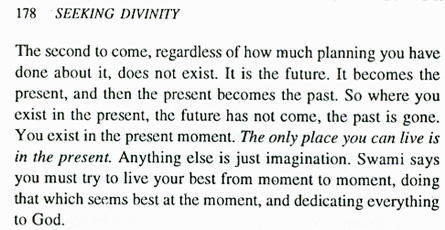 |
Comment: That the second that has not come ‘does not exist’, or that ‘the past is gone’ is self-evident and trivial indeed. Living from moment to moment doing your best is hardly amazingly sage advice. This kind of test typifies the shallowness of Hislop’s understanding, as well as that of Sathya Sai Baba. It makes far more sense to say that we live in relation to the past, present and future at all times. Sathya Sai Baba's oft-repeated claim that 'the past does not exist' is essentially claptrap |
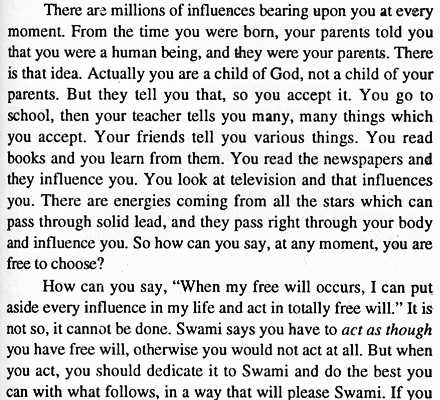 |
Comment: As to there being no free will, Hislop – like Sathya Sai Baba – fails ever to define free will or explain what is at issue. It is true that there are millions of influences on a person, but this does not mean that the person is driven by all (or even any) of these influences. Proponents of free will do not assert that one can put aside every influence in their lives to act totally in free will. That is a most unsophisticated notion of what free will consists in.
The commonsense idea of free will as volition means that a person can choose between alternative courses of action and that this choice is made depending on the alternatives open to the person and his or her evaluation of them. Hence, free will is related to and dependent upon voluntary action. Even in physiology, the distinction is made between voluntary action and involuntary reaction. Groups of cranial and spinal nerves are exclusively devoted to voluntary actions. Without these, the human being would be without free will (to move as one wishes, to act in the environment). This is the common sense basis of the idea of free will, understandable to everyone and enshrined in all human legal systems. Further, free will is in an important respect a variable quantity, in that some people have greater, some lesser, freedom of action (more or fewer alternatives they can really choose between). These alternatives are no doubt dependent on the many social, psychological and intellectual conditions at any given time for that person, but these conditions can also be changed through time by the exertion of will. For a fuller and deeper elucidation of these matters, see here. |
Hislop tells of Baba’s fallibility: The top Sathya Sai Organization leader in the USA through three decades, J. Hislop, eventually had to admit that Baba is 'fallible' (i.e. not omniscient) but - typically of his credulousness - he thought this to be a ‘wonderful’ fact demonstrating Baba’s human aspect. In this connection, Hislop said, “… there is this human side and in that human side there is some fallibility, up to a limit. It would be impossible for Him to do something that is wrong or destructive.” (“Seeking Divinity” Dr. J. S. Hislop, Sri Sathya Sai Books & Publications Trust. 1998, p. 210). Indeed, Sai Baba told Hislop in 1990 that he would not die before his wife, which she feared. “You will not die first. Long, long life.” Hislop lived only 5 years after that, and died of cancer without treatment in 1996 after a long period of sufferin. (Conversations with Bhagavan Sri Sathya Sai Baba New 1996 ed., p. 231)
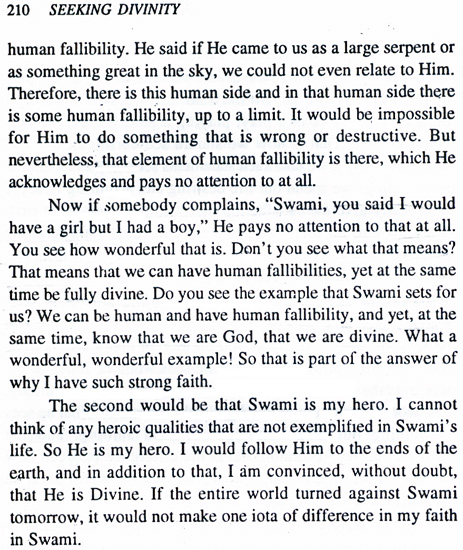 |
Comment: This credo of John Hislop shows how totally indoctrinated he was, how frantically he reaaffirmed his faith in the face of many very unpleasant and - for him - unanswerabvle questions with which was confronted in his post as a prime representative and defender of Sathya Sai Baba. Previously, no Sai leader would remotely consider (in public at least) that Baba could be fallible at all, and even today there are many who insist this is not so. But how could Hislop tell that there is a limit to Baba’s fallibility, or where it can be drawn? The only possible answer is, he certainly did not know! The extremity of his rationalization as seen here marks him as a person suffering from a major cognitive distortion of near-pathological dimensions.
As a letter to some Sathya Sai Organization leaders about homosexual/pedophile allegations against Baba in the early 1980s clearly demonstrated, he could simply not bring himself to believe in the evidence that Baba could ever have misused young men sexually. One naturally asks, how should this many-times disappointed seeker who thought he had at last found God Himself, admit that he had been so wrong, yet once again?
Baba even told him he has to be reborn again, despite his seeing many lingams come out of Baba’s mouth, which is supposed to guarantee liberation according to several assurances to this effect by SSB. (See Conversations with Bhagavan Sri Sathya Sai Baba New 1996 ed., p. 228). The poor man died before his wife, while SSB had assured him in 1990 would not occur. “You will not die first. Long, long life.” Hislop lived only 5 years after that, and died of cancer without treatment after a long period of suffering, (p. 231). It is not polite to ask whether his wife outlived him, one must assume. |
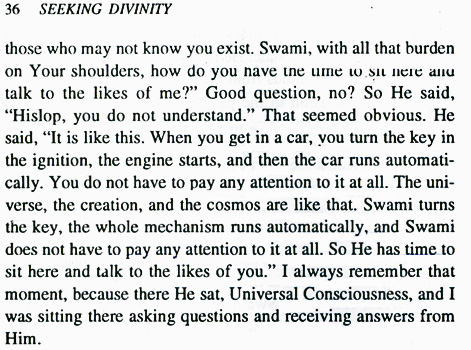 |
Comment: Dr. Hislop, for all his seeing divinity, is told he does not understand how the Creator of the Universe can sit around and chat! The absurdity of the exchange is priceless, particularly the facile answer. 'Swami just turns the key' - as if the beginning of the universe was akin to starting a car... a car that was already there waiting, perhaps? The chutzpah of Sathya Sai Baba exceeds all limits, but despite this, many Indian professionals - doctors of this and that, politicians, businessmen and more - still believe his claims and worship him! He was rather the 88th most popular Indian in 2010... which is higher than any reasonable person would hope, but still hardly the ranking one might expect for a God Incarnate, Creator of the entire Universe.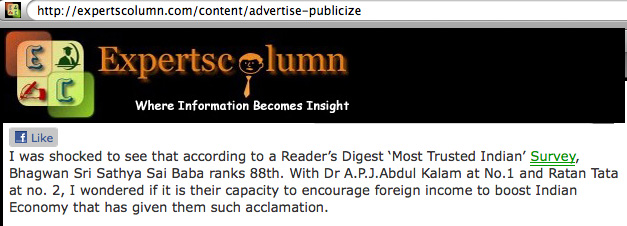 |
Hislop also argued that Sathya Sai Baba had resurrected a US millionaire, Mr. Walter Cowan, during a visit with him and his wife Elsie Cowan to Prashanthi Nilayam in the 1970s. This matter has been investigated and scans of the relevant critical pages of Professor Erlendur Haraldsson’s book detailing this are available as follows:- ‘Professor Erlendur Haraldsson contests Sai Baba’s claim of resurrection as bogus’.)
Sathya Sai Baba’s credibility gap: Contributions by John Hislop - Brian Steel 2009
See also:-
Review of 'Conversations with Bhagavan Sri Sathya Sai Baba' by Dr, John Hislop
Return to index menu





